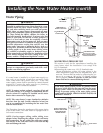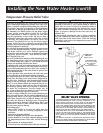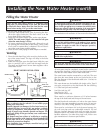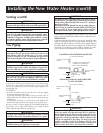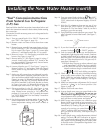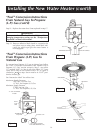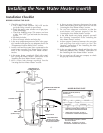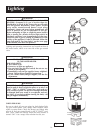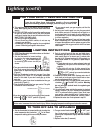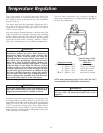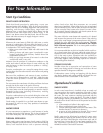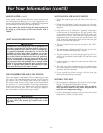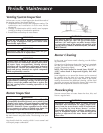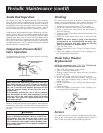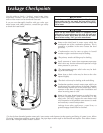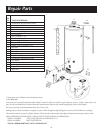
Temperature-Pressure Relief
Valve Operation
The temperature-pressure relief valve must be manually
operated at least once a year.
Periodic Maintenance (cont’d)
Service
If a condition persists or you are uncertain about the oper-
ation of the water heater, let a qualified person check it
out.
Call the local utility and/or plumbing inspector.
HANDLE AND
CAP ASSEMBLY
WASHER
Draining
The water heater should be drained if being shut down
during freezing temperatures. Also periodic draining and
cleaning of sediment from the tank may be necessary.
1. Turn the gas control knob to the “OFF” position.
2. CLOSE the cold water inlet valve to the water heater.
3. OPEN a nearby hot water faucet and leave open to
allow for draining.
4. Connect a hose to the drain valve and terminate to an
adequate drain.
5. OPEN the water heater drain valve to allow for tank
draining.
NOTE: If the water heater is going to be shut down
and drained for an extended period, the drain valve
should be left open with hose connected allowing
water to terminate to an adequate drain.
6. Close the drain valve.
7. Follow instructions in the “Filling The Water Heater”
section.
8. Follow the lighting instructions in the “Lighting” sec-
tion to restart the water heater.
Drain Valve Washer
Replacement
NOTE: For replacement, use a
17
⁄32
″″
x
13
⁄64
″″
x
1
⁄8
″″
thick wash-
er available at your nearest hardware store.
1. Turn “OFF” gas supply to water heater.
2. Follow “Draining” instructions.
3. Turning counter clockwise, remove the hex cap below
the screw handle.
4. Remove the washer and put the new one in place.
5. Screw the handle and cap assembly back into the
drain valve and retighten using a wrench. DO NOT
OVER TIGHTEN.
6. Follow instructions in the “Filling The Water Heater”
section.
7. Check for leaks.
8. Follow the lighting instructions in the “Lighting” sec-
tion to restart the water heater.
Failure to install and maintain a new properly listed tempera-
ture-pressure relief valve will release the manufacturer from
any claim which might result from excessive temperature or
pressure.
TEMPERATURE-PRESSURE
RELIEF VALVE
DISCHARGE PIPE
22
WARNING
When checking the temperature-pressure relief valve oper-
ation, make sure that (1) no one is in front of or around the
outlet of the temperature-pressure relief valve discharge
line, and (2) that the water manually discharged will not
cause any property damage because the water may be
extremely hot.
If after manually operating the valve, it fails to completely
reset and continues to release water, immediately close the
cold water inlet to the water heater, follow the draining
instructions, and replace the temperature-pressure relief
valve with a new one.
WARNING
If the temperature-pressure relief valve on the appliance
weeps or discharges periodically, this may be due to ther-
mal expansion. Your water heater may have a check valve
installed in the water line or a water meter with a check
valve. Consult the water supplier and/or plumbing inspec-
tor for further information. Do not plug the temperature-
pressure relief valve.
Anode Rod Inspection
The anode rod is used to protect the tank from corrosion.
Most hot water tanks are equipped with an anode rod. The
submerged rod sacrifices itself to protect the tank. Instead of
corroding the tank, water ions attack and eat away the anode
rod. This does not affect the water’s taste or color. The rod
must be maintained to keep the tank in operating condition.
Anode deterioration depends on water conductivity, not nec-
essarily water condition. A corroded or pitted anode rod indi-
cates high water conductivity and should be checked and/or
replaced more often than an anode rod that appears to be
intact. Replacement of a depleted anode rod can extend the
life of your water heater. Inspection should be conducted by
a qualified technician, and at a minimum should be checked
annually after the warranty period.



